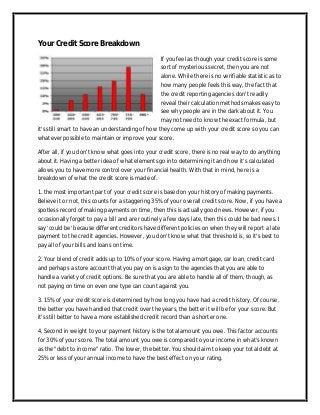
Your Credit Score Breakdown
- 1. Your Credit Score Breakdown If you feel as though your credit score is some sort of mysterious secret, then you are not alone. While there is no verifiable statistic as to how many people feels this way, the fact that the credit reporting agencies don't readily reveal their calculation methods makes easy to see why people are in the dark about it. You may not need to know the exact formula, but it's still smart to have an understanding of how they come up with your credit score so you can whatever possible to maintain or improve your score. After all, if you don't know what goes into your credit score, there is no real way to do anything about it. Having a better idea of what elements go into determining it and how it's calculated allows you to have more control over your financial health. With that in mind, here is a breakdown of what the credit score is made of. 1. the most important part of your credit score is based on your history of making payments. Believe it or not, this counts for a staggering 35% of your overall credit score. Now, if you have a spotless record of making payments on time, then this is actually good news. However, if you occasionally forget to pay a bill and are routinely a few days late, then this could be bad news. I say 'could be' because different creditors have different policies on when they will report a late payment to the credit agencies. However, you don't know what that threshold is, so it's best to pay all of your bills and loans on time. 2. Your blend of credit adds up to 10% of your score. Having a mortgage, car loan, credit card and perhaps a store account that you pay on is a sign to the agencies that you are able to handle a variety of credit options. Be sure that you are able to handle all of them, though, as not paying on time on even one type can count against you. 3. 15% of your credit score is determined by how long you have had a credit history. Of course, the better you have handled that credit over the years, the better it will be for your score. But it's still better to have a more established credit record than a shorter one. 4. Second in weight to your payment history is the total amount you owe. This factor accounts for 30% of your score. The total amount you owe is compared to your income in what's known as the "debt to income" ratio. The lower, the better. You should aim to keep your total debt at 25% or less of your annual income to have the best effect on your rating.
- 2. 5. New inquiries into your credit are a warning sign that you may be overextending yourself and account for 10% of your total score. The one exception is if you are the one looking at your credit report. As you can see, there is no real mystery when it comes to your credit score breakdown. Knowing how much weight is given to each portion of your score can help you decide where to first focus your efforts when you start trying to improve your credit score. Learn more at http://3creditscore.com/credit-score.